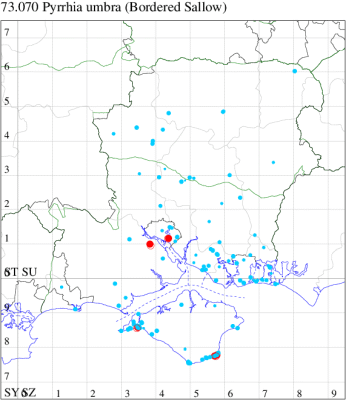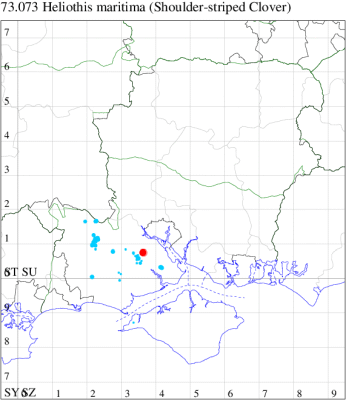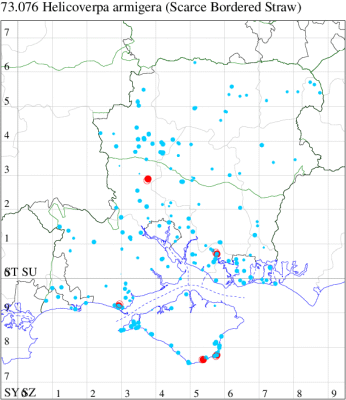2020 Annual Report for: Noctuidae / Heliothinae
For species seen in 2020 that had less than or equal to 100 records, full details are included; for more common species, the earliest, latest and highest count by vice-county are shown. The narrative for each species is taken from the main Hantsmoths website, and it is possible that some information on abundance and occurrence can get out of date, as it is impossible to keep up with all changes; however it should give a good introduction to each species. The tables in each species account summarise the previous status, and that for the current year.
For the maps, all records prior to 2020 are shown by a blue dot (the larger the dot, the more recent), with the current year's records shown in red. As previous records are superimposed on any report for 2020, new sites have greater emphasis (i.e. will show as 'more red').
In the species accounts, an asterisk next to a location indicates a new 10km square record; earliest ever dates are highlighted in orange, and latest ever in red. Initials in the species accounts refer to the recorders listed here. Please get in touch if you identify any omissions or errors, in particular if you have records that have yet to be submitted. Details of how to submit records can be found here.
73.070 [B&F: 2399] Bordered Sallow Pyrrhia umbra (Hufnagel, 1766) - Local
Local on sand-dunes and shingle beaches along the coasts of England, Wales and eastern Scotland, and inland on calcareous grassland in southern England. In Hampshire and on the Isle of Wight now a rare species, more or less confined to coastal localities and a few on the chalk, but occasional wanderers turn up at light away from established populations. Wingspan 34-41 mm. The most likely confusion species is Orange Sallow Xanthia citrago, which has forewing with antemedian and median fasciae almost straight and hindwing without black markings (MBGBI Vol 10). Larva feeds on flowers and seeds of Common Restharrow, Spiny Restharrow, Henbane and Sea Sandwort, over-wintering as a pupa.
Records prior to 2020
| Vice County | #Records | #Individuals | First Record | Last Record |
|---|---|---|---|---|
| 10 | 167 | 186 | 1856 | 2019 |
| 11 | 406 | 443 | 1945 | 2019 |
| 12 | 30 | 19 | 1945 | 2018 |
2020 records
| Vice County | #Records | #Individuals | Max Quantity |
|---|---|---|---|
| 10 | 18 | 30 | 4 |
| 11 | 3 | 3 | 1 |

Records by year
Records by week (adult)
Records by week (larval)
Record Details
VC10: Freshwater Cliffs, two, 09 Jul; two, 16 Jul (SDa); Wheelers Bay, one, 15 Jun; one, 22 Jul; one, 23 Jul (ABu); Bonchurch, one, 21 May; one, 26 May; one, 30 May; one, 07 Jun; one, 15 Jun; two, 17 Jun; one, 19 Jun; two, 20 Jun; one, 22 Jun; four, 24 Jun; three, 25 Jun; two, 12 Jul; three, 13 Jul (JHa);
VC11: Marchwood, one, 30 May; one, 20 Jun (CTh); Itchen: Peartree Green, one, 19 Jun (PAB); Northney, Hayling Island, present, 27 Jun; present, 13 Jul (JWP)
73.073 [B&F: 2402] Shoulder-striped Clover Heliothis maritima Graslin, 1855 - RDB3
A rare Red Data Book and a priority species under the UK Biodiversity Action Plan, now confined to acid heathland in Hampshire and neighbouring counties. In Hampshire more or less confined to the New Forest, where it occurs on damp heathland, although recent records have been few, with none since 1999. Recorded on the Isle of Wight for the first, and so far only, time at Freshwater in 1985. The south-eastern European subspecies has been recorded as a rare migrant in south-east Kent. Wingspan 32-37 mm. Day-flying, may come to light. The main confusion species is Marbled Clover H. viriplaca, which lacks the distinctive basal streak of H. maritima. Larva feeds on flowers of Cross-leaved Heath, over-wintering as a pupa.
Records prior to 2020
| Vice County | #Records | #Individuals | First Record | Last Record |
|---|---|---|---|---|
| 10 | 2 | 0 | 1955 | 1985 |
| 11 | 164 | 173 | 1800 | 2019 |
| 12 | 1 | 2 | 1952 | 1952 |
2020 records
| Vice County | #Records | #Individuals | Max Quantity |
|---|---|---|---|
| 11 | 1 | 0 | 0 |

Records by year
Records by week (adult)
Records by week (larval)
Record Details
VC11: Pottern Ford, NF, present, field observation, 01 Jul (RBW)
73.076 [B&F: 2400] Scarce Bordered Straw Helicoverpa armigera (Hübner, [1808]) - Migrant
A moderately frequent immigrant from southern Europe, north to Shetland. In Hampshire and on the Isle of Wight recorded in small numbers in most years, although the outstanding migrant year of 2006 saw over 320 individuals recorded. Wingspan 30-40 mm. The main confusion species are Bordered Straw Heliothis peltigera, which has forewing with a distinctive marginal dot above the tornus, and with reniform stigma usually joined to the costa by a dark triangular wedge, and Eastern Bordered Straw Heliothis nubigera, which has forewing more mottled, subterminal band more indented, and pronounced marginal dots (MBGBI Vol 10). Larva polyphagous, most likely to be found in Britain on imported fruit and cut flowers, but in its native range can be of commerical importance damaging crops such as Tomato and Maize.
Records prior to 2020
| Vice County | #Records | #Individuals | First Record | Last Record |
|---|---|---|---|---|
| 10 | 228 | 1052 | 1981 | 2019 |
| 11 | 515 | 698 | 1951 | 2019 |
| 12 | 169 | 235 | 1951 | 2019 |
2020 records
| Vice County | #Records | #Individuals | Max Quantity |
|---|---|---|---|
| 10 | 4 | 4 | 1 |
| 11 | 3 | 3 | 1 |

Records by year
Records by week (adult)
Records by week (larval)
Record Details
VC10: St Lawrence: Salem Close, one, to actinic, 28 Sep (PBa); Bonchurch, one, 30 Aug; one, 26 Sep; one, 21 Oct (JHa);
VC11: Kings Somborne, one, to actinic, 16 Nov (GCE); Fareham, one, 12 Aug (KJW); Northney, Hayling Island, present, 06 Jul (JWP); Milford on Sea, one, 17 Sep (MMcM); Southsea, one, 22 Oct (JRL)